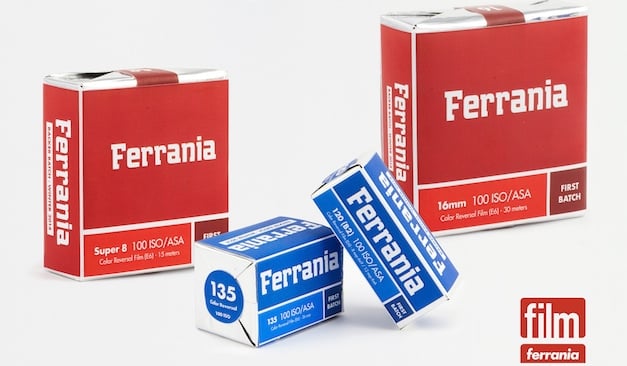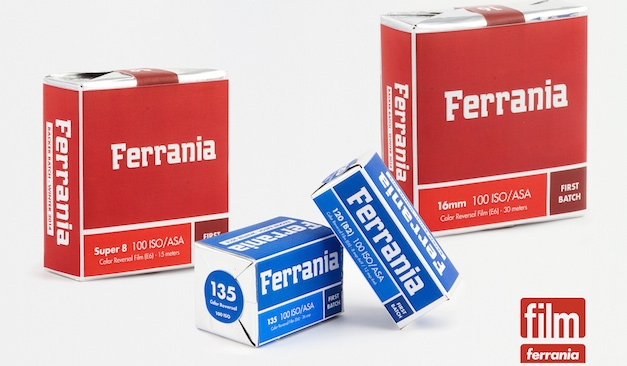

Film is dead, long live film. A Kickstarter campaign to resurrect one of the most famous names of the photochemical era, FILM Ferrania, has raced past its target and looks set to keep the ‘Made in Italy’ brand in business. By Fanjan Combrink.
It has been stated, screamed and argued that film is dead, that those who hold on to the medium are nostalgic and non-conformist. We have compared the two mediums from aesthetics to measurable quantitative absolutes. However the photosensitive film medium appears to be alive and well and one business in particular, with a rich history, has regrouped.
Phil Rhodes wrote an article last year in the early stages of the current story of FILM Ferrania (Analogue Film: the Sequel). Ferrania has a rich history in film production, starting out as a factory manufacturing chemicals for explosives back in World War I. Through the decades it has changed hands a few times, the last time just happening to be 3M’s biggest acquisition in its history — yes, 3M. One of the top guys at 3M mentioned years later than the Ferrania factory had better technology for film manufacturing and coating than 3M itself had.
The current analogue market
To manufacture photosensitive film is not an easy process by a long shot, and it is an expensive process too, especially when you have built and run a factory that has to supply film to the world when that was the only medium being used for cinema and stills.
With the emergence of digital technologies and their high uptake at the consumer level, it is fair to say that digital has won the race for majority market share, even in the movie business. The effect this has had on film manufacturing has been drastic, as has been seen by many when the lesser used film stocks have stopped being available on the shelf.
The same strength of film factories before digital is now their downfall: the minimum manufacturing quantity to keep a factory at break-even is too large for the current photosensitive film market. The other problem that these factories face is that to retool and downscale to serve the current market would cost more money than is sanely advisable. Ilford has been lucky enough, based on its film market share, to change and it is happily moving on and providing film to the market at volumes that are sustainable.
Kodak, Agfa, and Fuji have not been this fortunate. At least not yet if one considers what FILM Ferrania is up to.
Made in Italy
It is said that one of the biggest successes of Ferrania is probably that it became one of the largest film producers in the world for label brands: usually the only indication it was from the Ferrania factory was the words “Made in Italy”. However, the Ferrania brand is most associated with cinema film, names such as Fellini, De Sica, Sofia Loren, and Antonioni comes to mind. The classic 8½ was shot on Ferrania cinema film, and most of the Italian movies from 1923 to 1965.
The factory closed down in the last decade, most recently manufacturing film for the Imation brand, also owned by 3M. The factory building is set to be demolished by end of 2014, taking with it the machinery and all that made it one of only four factories in the world that can manufacture colour film for cinema and photography.
Yet, business partners Nicola Baldini and Marco Pagni have a bold plan. With the help of former Ferrania employees they have figured out that they could create a new “perfect size” factory by combining parts from the old big machinery to build a new factory for the current and future film market, both cinema and stills. A new factory that is responsive and flexible to the needs of the new market under the name FILM Ferrania.
The team is also in the fortunate position of having access to transparent film manufacturing machinery which will allow it to be a completely self contained facility that does not rely on purchasing semi processed film products from a third party. Raw materials goes in the one side, photosensitive film comes out the other.
The future of photosensitive film?
For FILM Ferrania to succeed in its endeavour they turned to the crowd funding community in order to raise funds for the first step of the business plan, with the tag of 100 Years of Analog Film. At the time of writing, it has surpassed its goal of $250,000 by $33,000 with 10 days to go in the campaign.
Kodak, Agfa, and Fuji have seen film demand even out in recent years, some even reporting slight increases in demand. A recent new article out of Tinsel Town also had directors planning to rally to “save film”. Many say that these directors, even the professional and amateur photographers who use film are merely nostalgic, even arrogant for insisting on shooting film.
The goal of FILM Ferrania is to offer artists in the photographic and motion picture communities, both amateur and professional, choice. The choice to choose the medium they feel serves the purpose the best, not the bottom line. It is not about “Film vs. Digital”; it is rather “Film or Digital”.
Often when I read comment denouncing film, arguing about nostalgia, listing endless articles showing the superiority of digital over film in some form or another or vice versa, I wonder if the same discussions are seen on other artistic expression forums. Would we see topics such as “How clay sculpting makes you a lazy sculptor”; how about “Which is better: water-based or oil-based paint?”, or even more strangely “Sketching with a pen, the death of the pencil”? I think not…
Tags: Production


Comments